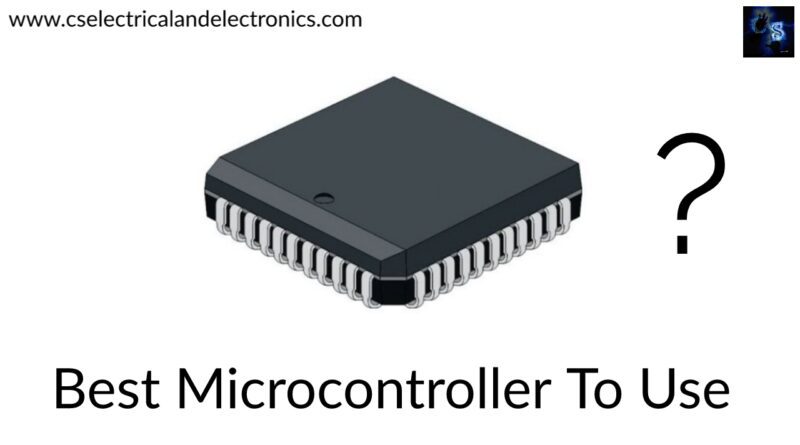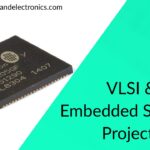Which Is Best Microcontroller To Use, Microcontroller For Engineers
Hello guys, welcome back to my blog. In this article, I will discuss which is the best microcontroller to use, the microcontroller for engineers, its features, pin description, and why to use that microcontroller only.
If you have any doubts related to electrical, electronics, and computer science, then ask question. You can also catch me @ Instagram – Chetan Shidling.
Also, read:
- 500+ Projects For Diploma Electrical, Electronics Student, Diploma Project.
- Applications Of Microcontrollers, Embedded System Applications.
- Difference Between 2G, 3G, 4G, 5G Technology, Benefits, Drawbacks.
Best Microcontroller To Use
A microcontroller is a single chip with the letters C or uC on it. VLSI is the fabrication technology used for the controller. The embedded controller is another term for a microcontroller. There are various microcontroller kinds available on the market today, including 4-bit, 8-bit, 64-bit, and 128-bit.
It’s a compressed microprocessor that controls embedded system functions in robots, office equipment, automobiles, household appliances, and other electronic devices. A CPU, peripherals, and memory are the different components found in a microcontroller. These are typically found in a variety of electrical gadgets that require the operator to exert some kind of control.
Which Microcontroller is Best to Use:-
Because it is a compact, low-cost, and self-contained computer-on-a-chip that can be utilized as an embedded system, the 8051 is the best microcontroller to employ and engineers to use. A few microcontrollers may run at clock rates and use four-bit expressions
Microcontroller 8051:-
It’s a 40-pin microcontroller with a 5V Vcc linked to pin 40 and a 0V Vss attached to pin 20. There are also input and output ports with an open-drain characteristic that range from P1.0 to P1.7. Port3 comes with a few extra functions. Inside the microcontroller, pin36 has an open-drain situation, and pin17 has an internally pulled up transistor.
When logic 1 is applied to port 1, logic 1 is applied to port 21, and vice versa. The microcontroller’s programming is extremely difficult. Basically, we write a program in C that is then transformed into machine language that the microcontroller understands. A capacitor is linked to pin9, which is connected to a RESET pin.
When the switch is turned on, the capacitor begins to charge, and RST rises. The microcontroller is reset by applying a high to the reset pin. When logic zero is applied to this pin, the program begins at the beginning.
Features of Microcontroller 8051:-
The main features of the 8051 microcontroller architecture include the following:
- An 8-bit CPU with two Registers A and B.
- 8K Bytes – Internal ROM, which is a flash memory that aids in-system programming.
- 256 Bytes – Internal RAM, with the first 128 Bytes from 00H to 7FH divided into four banks via eight registers in each bank, addressable registers -16 bit and general-purpose registers – 80.
- Special Function Registers occupy the remaining 128 bytes of RAM from 80H to FFH (SFRs). These registers manage several peripherals, including the Serial Port, Timers, and all I/O Ports.
- External-2 and Internal-3 interrupt.
- CLK Circuit and Oscillator.
- PCON, SCON, TMOD, TCON, IE, and IP are examples of control registers.
- 16-bit counters (T0 & T1) or 16-bit timers (T0 & T1).
- 16-bit program counter with DPRT (Data Pointer).
- I/O Pins — 32 I/O pins organized into four ports: P0, P1, P2, and P3.
- 8-bit Stack Pointer (SP) & PSW (Processor Status Word).
- Full-Duplex Serial Data Transmission and Reception.
Pin Description of Microcontroller 8051:-
- Pin-40: Vcc is the main +5V DC power supply.
- Pin 20: Vss – this pin represents the connection to the ground (0 V).
- Pins 32-39 serve as I/O ports and are known as Port 0 (P0.0 to P0.7).
- Pin-31: Address Latch Enable (ALE) demultiplexes the port 0 address-data signal.
- Pin-30: The External Access input (EA) controls whether external memory interfacing is enabled or disabled. This pin is always held high if no external memory is required.
- Pin 29: PSEN (Program Store Enable) reads signals from external program memory.
- Pins 21-28: Port 2 (P 2.0 to P 2.7) — in addition to serving as an I/O port, this semi bidirectional port multiplexes higher order address bus signals.
- Pins 18 and 19 are used to connect a system clock to an external crystal.
- Pins 10–17: In addition to interrupts, timer input, and control signals for external memory interfacing Read and Write, this port also serves other duties. This is a quasi-bidirectional port with a pull-up on the inside.
- Pin 9: This is a RESET pin that is used to reset the 8051 microcontrollers to their default values while the microcontroller is in use or when the application is first started. For two machine cycles, the RESET pin must be set high.
- Pins 1–8: This port isn’t used for anything else. Port 1 is a bi-directional I/O port in a sense.
Why 8051 Microcontroller is Best to Use (Benefits of Microcontroller):-
- It is simple to use, troubleshoot, and maintain, and it takes little time to complete a task.
- Because multiple jobs are often completed at the same time, the human effect is frequently saved.
- The processor chip is incredibly tiny, allowing for versatility.
- The system is less expensive and smaller in size.
- Adding additional RAM, ROM, and I/O ports to a microcontroller are simple.
- Microcontrollers cannot be reprogrammed after they have been programmed.
- If the digital components are missing, it will appear to be a microcomputer.
- It’s simple to use, with simple troubleshooting and system maintenance.
(8051) In contrast to microprocessors, which are used in personal computers and other devices, microcontrollers are mostly employed in embedded devices. These are mostly utilized in a variety of products such as implantable medical devices, power tools, automotive engine control systems, office equipment, remote-controlled appliances, toys, and so on.
To summarise, these microcontrollers are single-chip microcomputers that are manufactured using VLSI technology. These are also known as embedded controllers and come in four different sizes: four-bit, eight-bit, 64-bit, and one-hundred-bit. This chip is used to control several functions in embedded systems.
I hope this article may help you all a lot. Thank you for reading.
Also, read:
- 100 + Electrical Engineering Projects For Students, Engineers
- 1000+ Electronics Projects For Engineers, Diploma, MTech Students
- 1000+ MATLAB Simulink Projects For MTech, Engineering Students
- 500+ Embedded System Projects For Engineer, Diploma, MTech, PhD
- 500+ Projects For Diploma Electrical, Electronics Student, Diploma Project
- 8051 Microcontroller Timers, TCON Register, TMOD Register
- Advancements In 3D Printing Technology And It’s Future
- Advancements In Power Electronics For Energy Efficiency
Author Profile
- Content Writer
Latest entries
 All PostsAugust 25, 2021Top 16 Highest Paying Engineering Jobs in the USA For Freshers
All PostsAugust 25, 2021Top 16 Highest Paying Engineering Jobs in the USA For Freshers All PostsAugust 23, 2021Top 10 Smart Cities In The World, Best Cities To Visit In The World
All PostsAugust 23, 2021Top 10 Smart Cities In The World, Best Cities To Visit In The World All PostsAugust 21, 2021Top 20 VLSI & Embedded Systems Projects for Mtech Students
All PostsAugust 21, 2021Top 20 VLSI & Embedded Systems Projects for Mtech Students All PostsAugust 21, 2021Top 20 Power Systems Projects For MTech Students, Engineering Students
All PostsAugust 21, 2021Top 20 Power Systems Projects For MTech Students, Engineering Students








